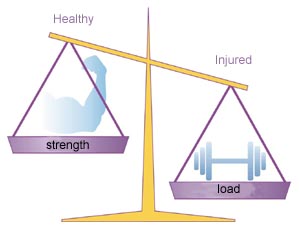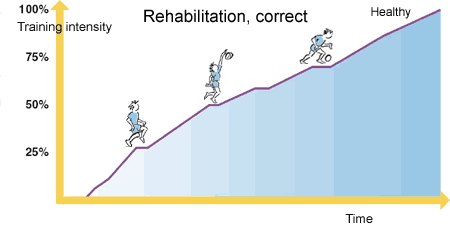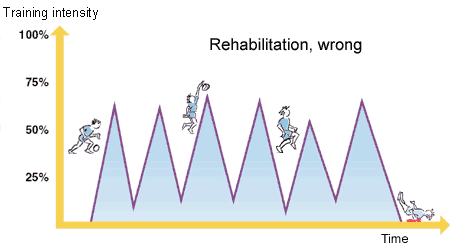|
The knowledge we have today does not present a clear-cut picture of the connection between the occurrence of injuries in relation to training intensity, bodily stature and the development of puberty. As with adults, sports injuries in young athletes occur when the tissue is subjected to a load that exceeds the strength of the tissue
It is therefore vital that the warning signals that the body sends out (pain, tenderness, reduced ability, swelling) are treated with the proper respect. Over-load injuries in young athletes are often centred on the bone growth zone (apophysis), as well as the muscle and tendon attachments. Over-load injuries are especially seen during the period of rapid growth at the beginning of puberty. The acute injuries primarily comprise fractures, stress fractures, tears, dislocations and ligament injuries. It is especially important for children and adolescents to be medically examined at the slightest sign of injury, unless of course the injury is very commonplace or trivial. The fact that many longer-term illnesses often present themselves in children for the first time in connection with performing sports and games must also be taken into consideration. This can, for example, include forms of arthritis or other medicinal conditions that involve the “moving parts”. Infections or cysts in the muscles or bones are often first seen showing discreet symptoms whilst doing sport. Although these conditions are relatively rare, it is naturally vital for the treatment’s result that the conditions are diagnosed as early as possible so that the correct treatment can be started. It is of utmost importance that all rehabilitation for children and adolescents is performed within the pain threshold. Young athletes are very often not good at registering and reacting to the body’s warning signals and adjusting rehabilitation to follow these signals (tenderness, swelling, reduced ability), which will entail a higher risk of the rehabilitation following a “saw tooth” pattern with alternating progress and relapse, instead of a steady but slower progress. This is the classic sign that the warning signals are not observed and respected, and that the rehabilitation is being forced quicker than the injured tissue can manage.
The social aspect associated with playing sport is of great importance for many children. It is therefore very important that rehabilitation exercises take place at the same time, and together with, the training of the team-mates who are not injured. It is always possible to prepare some rehabilitation exercises in one form or another which makes this achievable. It is therefore not optimal that “rehabilitation” consists of a total break from sport at home until the pain has gone before contacting the club to take part in normal training once again. All rehabilitation should therefore take place at the same location as the training for the team-mates that are not injured, and of course to the extent possible, the injured children should participate with the others in the normal training (i.e. warming up, light technical exercises, etc.). When the “normal” training involves exercises that the injured team mate can not take part in at the actual stage of his rehabilitation, the person injured can perform some special exercises, but in the same area as the others. The majority of sports injuries in children and adolescents can be treated with short-term relief, whilst other injuries will require a simple rehabilitation programme that can be found and downloaded from the children’s section of www.sportnetdoc.com. These exercises can in many cases be made more specific to the actual sport, and be amended so that they can be performed at the same place and at the same time as the non-injured team-mates. Some more serious injuries in children and adolescents will demand a more detailed and specialised rehabilitation program, which to a large extent can be found and downloaded from the adult section of www.sportnetdoc.com. It is important to point out that a standard rehabilitation program cannot be a substitute for a specific medical evaluation of the injury, and specific instruction. |



